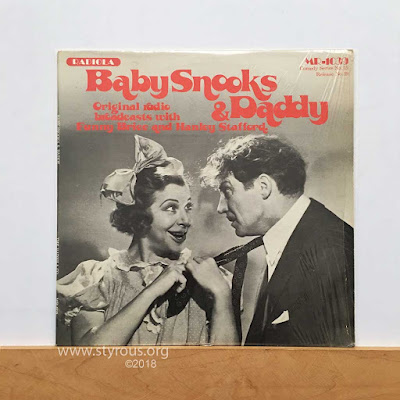~
photo: September 25, 1945
Fanny Brice ~
Baby Snooks & Daddy
photo: September 25, 1945
photo: film still
detail photo of record cover by Styrous®
This album does not have music, it consists of eight radio episodes of Baby Snooks & Daddy performed and recorded live before a studio audience from 1948 to 1950.
detail photos of record cover by Styrous®
Brice's first radio show was the
Philco Hour in February 1930. From the 1930s until her death in 1951, she made a radio presence as a bratty toddler named Snooks, a role she premiered in a
Follies skit co-written by playwright
Moss Hart.
Baby Snooks premiered in
The Ziegfeld Follies of the Air in February 1936 on
CBS, with
Alan Reed playing Lancelot Higgins, her beleaguered "Daddy". Brice moved to
NBC in December 1937, performing the Snooks routines as part of the
Good News show, then back to
CBS on
Maxwell House Coffee Time, with the half-hour divided between the Snooks sketches and actor
Frank Morgan.
photo: film still
photo of record cover by Styrous®
Brice was so meticulous about the program and the title character that
she was known to perform in costume as a toddler girl even though seen
only by the radio studio audience. She was 45 years old when the
character began her long radio life.
photographer unknown
Thirteen years after her death, Brice was portrayed on the Broadway stage by
Barbra Streisand in the 1964 musical
Funny Girl; Streisand also starred in its
1968 film adaptation, for which she won an Oscar, and in the 1975 sequel,
Funny Lady.
detail photos of record cover by Styrous®
She told biographer Norman Katkov:
"Snooks is just the kid I used to be.
She's my kind of youngster, the type I like. She has imagination. She's
eager. She's alive. With all her deviltry, she is still a good kid,
never vicious or mean. I love Snooks, and when I play her I do it as
seriously as if she were real. I am Snooks. For 20 minutes or so, Fanny
Brice ceases to exist."
Though Brice reportedly spoke no Yiddish, she played into the popularity of ethnic comedy by adopting stereotypical mannerisms and the accent. In 1910 she began her association with
Florenz Ziegfeld, headlining his
Ziegfeld Follies in 1910 and 1911. She was hired again in 1921 and performed in the
Follies into the 1930s. In the 1921
Follies, she was featured singing
My Man, which became both a big hit and her signature song. She made a popular recording of it for the
Victor Talking Machine Company. The second song most associated with Brice is
Second Hand Rose, which she also introduced in the
Ziegfeld Follies of 1921.
Tracklist:
Side 1:
A1 - The Cat-Man's Revenge
A2 - Abnormal Psychology
A3 - The Man Who Came To Dinner
A4 - The Trial
Side 2:
B1 - The World's Most Patient Father
B2 - At The Doctor's...
B3 - To Bee Or Not To Bee
B4 - Snooks And Tallulah
Fanny Brice, Hanley Stafford – Baby Snooks & Daddy
Label: Radiola – MR-1039
Series: Comedy Series – No. 15
Format: Vinyl, LP
Country: USA, Canada & UK
Released: 1974
Genre: Non-Music
Viewfinder links:
Net links:
YouTube links:
"I lived the way I wanted to live and
never did what people said I should do."
~ Fanny Brice
Styrous® ~ Thrusday, October 29, 2020




























